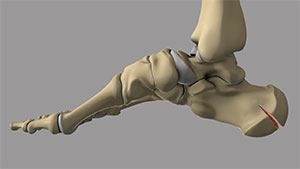Heel Fractures

The calcaneus or heel bone is a large bone found at the rear of the foot. A fracture is a break in a bone from trauma or a disease condition. Calcaneus fractures are categorised based on their severity and include stable fractures, displaced fractures, open fractures, closed fractures and comminuted fractures.
A fracture of the calcaneus occurs most commonly due to a traumatic event such as falling from a height, twisting injuries, motor vehicle accidents and ankle sprains.
The commonly seen signs and symptoms of calcaneal fractures include pain, swelling, bruising and inability to walk or bear weight on the foot.
Your doctor evaluates calcaneal fractures by ordering imaging studies such as X-rays and CT scans.
A fracture of the calcaneus is considered serious and can cause problems if not treated correctly. Calcaneal fractures are treated based on the type of fracture and extent of soft tissue damage. Nonsurgical treatment is advised for non-displaced fractures and may include:
- Rest, ice, compression and elevation (R.I.C.E.): This is the most commonly suggested treatment option. Staying off (resting) the injured foot can heal the fracture. Covering the affected area with ice packs over a towel reduces swelling and pain. Compression stockings or elastic bandages, and positioning your feet above your heart level reduces swelling.
- Immobilisation: Casting the injured foot prevents the fractured bone from moving. Walking with the help of crutches is advisable to avoid bearing body weight until healing has occurred.
Surgical treatment is recommended for severe traumatic fractures and may include:
- Open reduction and internal fixation (ORIF): This surgery involves putting the bone fragments back together in normal alignment and holding them in position with metal plates and screws until the bone heals.
- Percutaneous screw fixation: This is the preferred treatment in cases where the fractured bone pieces are large. The bone can either be pushed or pulled to set into place without making a large incision. Metal screws are then inserted and fixed through small incisions to hold these bone pieces together.
Irrespective of the treatment procedure, physiotherapy and regular simple exercises are recommended to help restore function.













